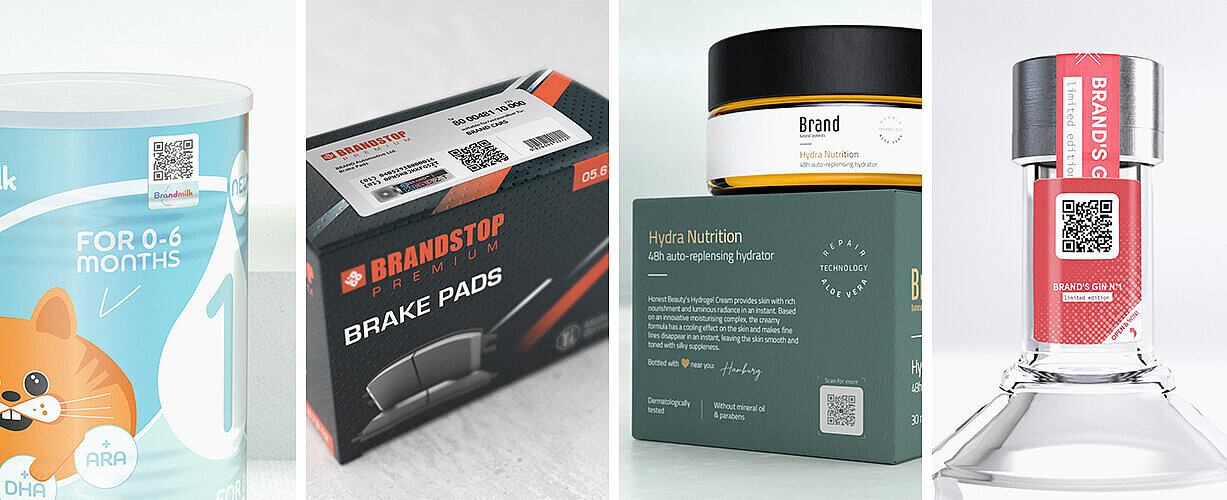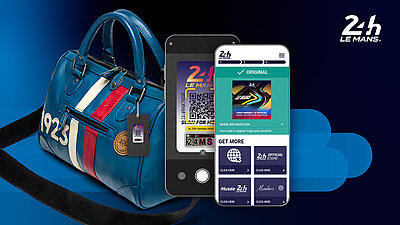All You Need to Know about Anti-Counterfeiting Labels

Anti-counterfeiting labels are specifically designed to prevent the unauthorized reproduction or imitation of products. These labels often include features such as unique serial numbers, hidden patterns, holograms, taggants or authentication codes that can be verified by consumers or anyone along the supply chain to ensure the authenticity of the product.
Anti-counterfeiting labels can be used in a variety of industries and applications where there is a risk of counterfeit products entering the market. Some common areas where anti-counterfeiting labels are used include:
Electronics: Electronics manufacturers use anti-counterfeiting labels to protect their products like head phones, phone accessories etc. from being counterfeited or tampered with, ensuring the safety and quality of the products.
Luxury goods: High-end brands often use anti-counterfeiting labels on products like luxury watches, handbags, shoes or high-end apparel to protect their brand reputation and prevent counterfeit products from entering the market.
Wine and spirits: Anti-counterfeiting labels are used in the wine and spirits industry for products like expensive spirits or whisky and gins to prevent counterfeit products from being sold to consumers, ensuring the safety and authenticity of the products.
Automotive parts: Anti-counterfeiting labels are used on automotive parts to ensure the safety and reliability of the products, as counterfeit parts can pose serious risks to vehicle performance and safety. Especially the market for original automotive parts (OEM) and the independent aftermarket (IAM) are affected by product counterfeiting and grey market trade.
Overall, anti-counterfeiting labels can be used in any industry where there is a need to protect products, documents or assets from counterfeiting and unauthorized duplication.
What features do anti-counterfeit labels exhibit?
Security labels often incorporate multiple levels of security features to protect against counterfeiting and tampering. These features are categorised into four levels: overt, semi-overt, covert, and forensic. Overt features are easily visible, while semi-overt features require simple aids like a magnifying glass. Covert features need special tools like UV flashlights or a dedicated reader / smart phone adapter and forensic features require advanced laboratory equipment. By using a combination of these security features, manufacturers can ensure the integrity of their products and brand.
Level 1 Overt features: Overt features are visible security elements that are easily recognisable without the need for special tools or equipment. These features are typically designed to be easily identified by consumers, inspectors, or retailers to quickly verify the authenticity of the product. Examples of overt features include:
- Unique serial numbers: Unique serial numbers or codes printed on security labels serve as an overt feature that allows for easy verification and tracking of authenticity for products
- Moving code: A moving code is a dynamic security feature that changes or moves when viewed from different angles
- LED Code: An LED code is a security feature that uses Light Emitting Diodes (LEDs) in security labels for visible authenticity
- Tamper-evident seals: Labels or seals that show evidence of tampering when removed or tampered with. Our security seals ensure the security of your product and packaging throughout the entire logistics chain with easily recognisable evidence of initial opening. Once the tamper seal is opened or tampered with, it immediately displays a void effect that is irreversible. This first-opening effect remains visible even if an attempt is made to reseal the tamper-evident seal.
- Holograms: Holographic images or patterns that change appearance when viewed from different angles.
- Color-shifting inks: Inks that change color when tilted or viewed under different lighting conditions
- Special design features: Guilloche lines, serial numbers that vary in size or follow special lines
- Security fibers: Fibers or threads embedded into the label material that are difficult to reproduce
- Color-changing inks or UV features: Labels with color-changing inks or UV features that are only visible under specific lighting conditions.
Level 2 Semi-overt features: In the context of anti-counterfeit labels, semi-overt security features refer to security measures that provide a certain level of accessibility to users while maintaining restrictions to prevent counterfeiting or tampering with the labels. These features are designed to strike a balance between allowing consumers to verify the authenticity of a product or label, while making it difficult for counterfeiters to replicate or manipulate the security features. These features can be authenticated with simple equipment that is easily accessible to everybody such as a smartphones, magnifying glasses or flashlights.
Examples:
- Holograms with hidden features: Holographic labels with hidden or covert features that are only visible under specific conditions or with special equipment. This adds an additional layer of security that is not easily replicable by counterfeiters. Our innovative ValiGate® Zoom combines our proven security technology with KURZ’s holographic products. This innovative solution turns a covert feature (level 3) into a semi-covert feature (level 2), as for the first time in the world, a hologram can be checked for authenticity using a simple tool (smartphone). There is no need for an adapter, application or training.
- QR codes or barcodes with encrypted information: QR codes or barcodes on the label that contain encrypted information, such as a unique serial number or product details. Authorized users can scan the code to verify the authenticity of the product, while counterfeiters would have difficulty replicating the encrypted data. Our ValiGate® Direct Print provides robust defense against counterfeiting, enabling customers to effortlessly verify products and distinguish fake goods. By leveraging the full QR code to incorporate its patented security design, ValiGate® guarantees protection without requiring expensive random patterns or fingerprint technology. This ensures that the distinctive security element cannot be duplicated or reverse-engineered.
- ValiGate® Direct Print stands out for its ability to be directly imprinted on packaging, minimizing material wastage and eliminating the necessity for extra labels or inks. This eco-conscious solution not only boosts recyclability but also streamlines application processes and lessens your environmental impact.
- Microtext/Micro code: Tiny text or patterns that are only visible under magnification.
- Watermarks: Watermarks can serve as semi-overt security features, such as hidden watermarks that appear under specific lighting conditions or angles, and small colored pixels that are invisible to the naked eye but detectable through a camera app. While these watermarks offer protection against unauthorized reproduction through basic copying methods, they can be identified and replicated with a magnifying glass or high-resolution scan.
- NFC: NFC (Near Field Communication) technology enables short-range communication between devices, typically within a range of up to 4 centimetres, used for contactless payment systems and data transfer at frequencies of 13.56 MHz. NFC technology can act as a semi-overt security feature by enabling secure communication between devices in close proximity. NFC tags or devices can be embedded in physical items or documents and can be scanned or read by NFC-enabled devices, such as smartphones or tablets. This technology provides a convenient way to authenticate and verify the legitimacy of items, as the NFC tag may not be visible to the naked eye but can be easily detected and interacted with using compatible devices.
Level 3 Covert features: Covert features are hidden security elements that are not immediately visible to the naked eye and require special tools or equipment such as UV flashlights, laser or decoder films to be detected. These features are often used for additional security and are designed to be difficult for counterfeiters to replicate.
Examples of covert features include:
- Laser code: Laser code is a covert holographic feature, developed by KURZ SCRIBOS, that involves encoding information onto the label using a laser, requiring special equipment to detect and read the information.
- Lens code: Special pattern that does not show any information to the naked eye. When a special decoder film (card) is put on the pattern a (until then) invisible information is revealed. KURZ SCRIBOS uses this to show a unique serial number, which is different on each label.
- RFID technology: Radio-frequency identification (RFID) chips that can be scanned to verify the authenticity of the label. RFID (Radio Frequency Identification) technology uses radio waves to identify and track objects, commonly employed in inventory management and access control systems operating at frequencies ranging from 860 -960 MHz with ranges varying from a few centimetres to several meters, depending on the frequency used. RFID can also act as a covert security feature because RFID tags can be embedded discreetly within items, making them invisible to the naked eye. This hidden placement adds an additional layer of security as the presence of RFID tags may go unnoticed by individuals attempting to tamper with or counterfeit the item.
- UV printing: Print that is only visible under ultraviolet (UV) light.
Level 4 Forensic features: Forensic features in anti-counterfeiting labels are specialized security measures that are designed to be detectable only by trained professionals or through advanced forensic techniques. These features are often covert or hidden, making them difficult for counterfeiters to replicate or detect, and are used to provide an additional layer of security and authentication for products. These features can only be revealed by using specialized equipment or methods, which are mostly only available in special laboratories.
Examples:
- DNA Marking: Unique DNA markers or tags embedded in products or documents for authentication purposes. DNA marking can be analyzed forensically to confirm the origin of an item. It is worth mentioning that these markers are also available as covert features (level 3) that can be authenticated using a specialized reader, such as the VerifyMe reader. This reader includes a smartphone adapter with a light source featuring different wavelengths and filters, enabling the phone camera to read the markers.
- Microscopic Taggants: Microscopic particles or markers added to inks, dyes, or materials that can be detected and analyzed under a microscope for verification.
- Chemical Tracers: Invisible chemical compounds added to products that can be detected through chemical analysis to confirm authenticity.
- Spectral Analysis: Security features that are only visible under specific lighting conditions or when viewed through specialized equipment for authentication.
- Microscopic Security Fibers: Extremely small fibers embedded in materials that are difficult to replicate and can be analyzed forensically for verification.
By incorporating a combination of overt semi-overt, covert and forensic features into security labels, manufacturers can create a multi-layered security solution that offers both visible and hidden protection against counterfeiting and tampering. This multi-layered approach ensures that different target groups (dealer, wholesalers, warehouses, retailer, POS, customs, internal experts or detectives) have access to varying levels of security features, providing comprehensive protection against counterfeiters and ensuring the authenticity of the product throughout the supply chain. By combining overt, semi-overt, covert, and forensic features, manufacturers can create a robust security label that meets the needs of different stakeholders while maintaining the integrity of their brand and products.
What are the advantages of adding a security label?
From the perspective of a brand owner, integrating security labels into product packaging provides numerous benefits in terms of protecting brand reputation, revenue, and compliance with industry regulations.
For customers, security labels offer undoubted certainty that the product they are purchasing is genuine and safe to use. This assurance is particularly crucial in industries where counterfeit items pose a risk to health and safety, such as counterfeit alcohol, brake discs, or milk powder. By being able to easily authenticate products through security labels, consumers can make informed decisions and avoid the potential dangers associated with counterfeit goods.
Moreover, security labels enhance the overall customer experience by providing a quick and reliable method for verifying product authenticity. This added layer of protection instils confidence in consumers, fostering trust and loyalty towards the brand. Customers are more likely to continue purchasing from a brand that prioritizes product quality and safety through the implementation of security labels.
In summary, security labels not only benefit brand owners by safeguarding their products and reputation but also offer peace of mind to consumers by ensuring the authenticity and safety of the products they purchase. By prioritizing product security, brands can build stronger relationships with customers and differentiate themselves in the market, ultimately driving repeat business and long-term success.
When is it a must to add a security label?
Adding a security label to your product is often considered a must in the following situations:
High-risk industries: Industries with a high risk of counterfeiting, such as pharmaceuticals, electronics, luxury goods, wine & spirits, FMCG (milk powder) and automotive parts, often require the use of security labels to protect their products and brand reputation.
Regulatory requirements: Some industries are mandated by regulatory authorities to implement security measures, including security labels and/or serialization, to ensure product authenticity and safety. Non-compliance with these regulations can result in fines or legal consequences.
High-value products: Products with a high value, either monetarily or in terms of importance, such as government documents, collectibles, luxury items, or high-end consumer goods, often require security labels to protect against counterfeiting and unauthorized tampering. Counterfeiters think economically and love to fake product with high margins.
Supply chain security: In industries where product integrity and traceability are critical, such as food and pharmaceuticals, security labels are essential to ensure the authenticity of products throughout the supply chain and prevent theft, diversion or tampering. Security labels especially play a crucial role in combating grey market trading, also known as parallel trading. Labels help ensure that genuine products are sold in their intended location and through authorized distribution channels, preventing overproduction and unauthorized sales on the grey market.
In these scenarios, adding a security label to your product is not only recommended but often necessary to safeguard your business, comply with regulations and protect consumers from counterfeit products.
What is special about KURZ SCRIBOS security labels?
KURZ SCRIBOS security labels are distinguished by their multi-level authentication features, spanning from overt (Level 1) to semi-overt (Level 2) to covert (Level 3) and forensic (Level 4), ensuring comprehensive product security. All labels are meticulously crafted using proprietary technology, including self-developed know-how, machinery, software, label material, and authentication tools, setting them apart as unparalleled in the global market. The KURZ SCRIBOS holographic security features display a unique shimmering serial number within a holographic rainbow effect, unmatched by any other provider worldwide.
Our extensive range of security label options includes standalone labels, interactive labels, or integration into existing product labels, providing flexibility to meet diverse security needs. Each label can be fully customized in terms of decoration, material, size, shape, design, application, and functionality, allowing brand owners to tailor the security solution to their specific requirements. From high-end Level 4 holographic features with multiple security levels like LaserCode, LEDCode, MovingCode, and LensCode, to cost-effective scalable printed security features such as ValiGate® Direct Print or uniQR, the KURZ SCRIBOS brand offers a comprehensive selection to meet the unique needs of each client.
Moreover, KURZ SCRIBOS labels are linked to the SCRIBOS 360 digital platform, enabling comprehensive tracking and analysis of product activities This innovative system offers a range of features, including grey market detection, customer interaction capabilities, and detailed analytics. However, simply identifying counterfeits on a map is not enough to address the issue. KURZ SCRIBOS takes brand protection to the next level by offering actionable recommendations, facilitating test buys through our online brand protection partner globaleyez, and providing crucial digital information to law enforcement agencies. This holistic approach ensures that counterfeit products are not only identified, but effectively removed from the market, ultimately safeguarding brands and consumers alike.
We would love to consult you, which anti-counterfeiting label is your perfect fit. Contact us at hello@kurz-scribos.com.




